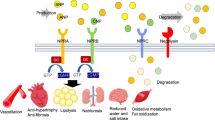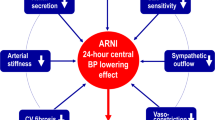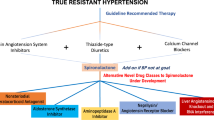Abstract
The available angiotensin II type 1 (AT1)-receptor blockers differ markedly in their pharmacological properties and clinical efficacy. Losartan shifts the dose-response curve for angiotensin II to the right without affecting the maximal response; this antagonism can be overcome by increasing concentrations of angiotensin II and thus losartan acts as a surmountable antagonist. By contrast, other agents suppress the maximal response to angiotensin II to varying extents; this can not be overcome by increasing angiotensin concentrations and hence these agents are insurmountable antagonists. Receptor binding studies have shown that candesartan has the highest affinity for the AT1-receptor, followed by irbesartan, valsartan and losartan, and that candesartan dissociates from the receptor more slowly than other antagonists. A meta-analysis using an EMax model has shown that differences in receptor binding activity are reflected in differences in maximal antihypertensive effect, and this finding is supported by the results of comparative clinical trials. Moreover, the prolonged binding of candesartan to the receptor is reflected in a longer duration of action, compared with losartan; the antihypertensive effect of candesartan persists for 48 h after dosing, compared with approximately 24 h with losartan. Candesartan thus offers extended therapeutic coverage, an important consideration since a majority of patients miss occasional doses of antihypertensive medication. There is currently no evidence that differences in receptor binding between AT1-receptor blockers translate into differences in tolerability. In summary, therefore, pharmacological differences between AT1-receptor blockers are reflected in clinically important differences in maximal antihypertensive effect, response rate, and duration of action.
This is a preview of subscription content, access via your institution
Access options
Subscribe to this journal
Receive 12 digital issues and online access to articles
$119.00 per year
only $9.92 per issue
Buy this article
- Purchase on Springer Link
- Instant access to full article PDF
Prices may be subject to local taxes which are calculated during checkout






Similar content being viewed by others
References
Timmermans PB et al. Angiotensin II receptors and functional correlates Am J Hypertens 1992 5 (12 Pt 2): 221S–235S
Dzau VJ, Sasamura H, Hein L . Heterogeneity of angiotensin synthetic pathways and receptor subtypes: physiological and pharmacological implications J Hypertens 1993 11 (Suppl): S13–S18
Booz GW, Baker KM . Role of type 1 and type 2 angiotensin receptors in angiotensin II-induced cardiomyocyte hypertrophy Hypertension 1996 28: 635–640
Ford WR, Clanachan AS, Jugdutt BI . Opposite effects of angiotensin AT1 and AT2 receptor antagonists on recovery of mechanical function after ischaemia-reperfusion in isolated working rat hearts Circulation 1996 94: 3087–3089
Johnston CI . Angiotensin II type 1 receptor blockade: a novel therapeutic concept Blood Press 2000 9 (Suppl I): 9–13
Meredith PA . Clinical comparative trials of angiotensin II type 1 (AT1)-receptor blockers Blood Press 2001 10 (Suppl 3): 11–17
Morsing P, Vauquelin G . How can the differences among AT1-receptor antagonists be explained? Cell Biochem Biophys 2001 35: 89–102
Vanderheyden PML, Fierens FLP, Vauquelin G . Angiotensin II type 1 receptor antagonists Why do some of them produce insurmountable inhibition? Biochem Pharmacol 2000 60: 1557–1563
Vauquelin G, Fierens FLP, Vanderheyden PML . Distinction between surmountable and insurmountable angiotensin II AT1 receptor antagonists. In: Epstein M, Brunner HR (eds) Angiotensin II receptor antagonists Hanley & Belful: Philadelphia 2000 105–118
Morsing P et al. Mechanistic differences of various AT1-receptor blockers in isolated vessels of different origin Hypertension 1999 33: 1406–1413
Noda M et al. Inhibition of rabbit aortic angiotensin II (AII) receptor by CV-11974, a new nonpeptide AII antagonist Biochem Pharmacol 1993 46: 311–318
Fabiani ME et al. In vivo inhibition of angiotensin receptors in the rat kidney by candesartan cilexetil: a comparison with losartan Am J Hypertens 2000 13: 1005–1013
Ojima M et al. Candesartan (CV-11974) dissociates slowly from the angiotensin AT1 receptor Eur JPharmacol 1997 319: 137–146
Vanderheyden PML, Fierens FLP, De Backer JP, Vauquelin G . Reversible and syntopic interaction between angiotensin receptor antagonists on Chinese hamster ovary cells expressing human angiotensin II type 1 receptors Biochem Pharmacol 2000 59: 927–935
Fierens FL, Vanderheyden PM, De Backer JP, Vauquelin G . Binding of the antagonist [3H]candesartan to angiotensin II AT1 receptor-transfected Chinese hamster ovary cells Eur J Pharmacol 1999 367: 413–422
Fierens FL, Vanderheyden PM, De Backer JP, Vauquelin G . Insurmountable angiotensin AT1 receptorantagonists: the role of tight antagonist binding Eur JPharmacol 1999 372: 199–206
Azizi M, Bernard MC, Ménard J . Pharmacokinetic-pharmacodynamic study of renin release during angiotensin II blockade J Hypertens 1999 17 (Suppl 3): S195
Azizi M, Chatellier G, Guyene T-T, Ménard J . Pharmacokinetic-pharmacodynamic interactions of candesartan cilexetil and losartan J Hypertens 1999 17: 561–568
Gradman AH et al. A randomized, placebo-controlled, double-blind, parallel study of various doses of losartan potassium compared with enalapril maleate inpatients with essential hypertension Hypertension 1995 25: 1345–1350
Elmfeldt D, George M, Hübner R, Olofsson B . Candesartan cilexetil, a new generation angiotensin II antagonist, provides dose dependent antihypertensive effect J Hum Hypertens 1997 11 (Suppl 2): s49–s53
Reeves LA, Lin C-S, Kassler-Taub K, Pouleur H . Dose-related efficacy of irbesartan for hypertension. An integrated analysis Hypertension 1998 31: 1311–1316
Pool J et al. Dose-responsive antihypertensive efficacy of valsartan, a new angiotensin II-receptor blocker Clin Ther 1998 20: 1106–1114
Hansson L . The relationship between dose and antihypertensive effect for different AT1-receptor blockers Blood Press 2001 10 (Suppl 3): 33–39
Andersson OK, Neldam S . The antihypertensive effect and tolerability of candesartan cilexetil, a new generation angiotensin II antagonist, in comparison with losartan Blood Press 1998 7: 53–59
Bakris G et al. Antihypertensive efficacy of candesartan in comparison to losartan: the CLAIM study J Clin Hypertens (Greenwich) 2001 3: 16–21
Kassler-Taub K et al. Comparative efficacy of two angiotensin II receptor antagonists, irbesartan and losartan in mild-to-moderate hypertension. Irbesartan/ Losartan Study Investigators Am J Hypertens 1998 11 (4 Pt 1): 445–453
Oparil S et al. An elective-titration study of the comparative effectiveness of two angiotensin II-receptor blockers, irbesartan and losartan. Irbesartan/Losartan Study Investigators Clin Ther 1998 20: 398–409
Hedner T et al. A comparison of the angiotensin II antagonists valsartan and losartan in the treatment of essential hypertension Am J Hypertens 1999 12 (4 Pt 1): 414–417
Joint National Committee. Sixth National Report of the Joint National Committee on Prevention, Detection, Evaluation and Treatment of High Blood Pressure (JNC VI) Arch Intern Med 1997 157: 2413–2446
Lacourcière Y, Asmar R . A comparison of the efficacy and duration of action of candesartan cilexetil and losartan as assessed by clinic and ambulatory blood pressure after a missed dose, in truly hypertensivepatients. A placebo-controlled, forced titration study Am J Hypertens 1999 12: 1181–1187
Mallion JM et al. A placebo-controlled comparison between candesartan cilexetil 8 mg and losartan 50 mg monotherapy inpatients with essential hypertension using 36H ambulatory blood pressure monitoring JRAAS 2000 1: 104
Mallion J, Siche J, Lacourcière Y . ABPM comparison of the antihypertensive profiles of the selective angiotensin II receptor antagonists telmisartan and losartan inpatients with mild-to-moderate hypertension J Hum Hypertens 1999 13: 657–664
Fogari R et al. Comparative efficacy of valsartan and losartan in mild-to-moderate hypertension: results of 24-hour ambulatory blood pressure monitoring Curr Ther Res 1999 60: 195–206
Monterroso VH et al. Use of ambulatory blood pressure monitoring to compare antihypertensive efficacy and safety of two angiotensin II receptor antagonists, losartan and valsartan. Losartan Trial Investigators Adv Ther 2000 17: 117–131
Mancia G et al. Irbesartan results in superior blood pressure control vs valsartan J Hypertens 2000 18 (Suppl 2): S208
Littlejohn T et al. A prospective, randomized, open-label trial comparing telmisartan 80 mg with valsartan 80 mg inpatients with mild to moderate hypertension using ambulatory blood pressure monitoring Can J Cardiol 2000 16: 1123–1132
Rudd P et al. Issues inpatient compliance: the search for therapeutic sufficiency Cardiology 1992 80 (Suppl 1): 2–10
Author information
Authors and Affiliations
Rights and permissions
About this article
Cite this article
Gradman, A. AT1-receptor blockers: differences that matter. J Hum Hypertens 16 (Suppl 3), S9–S16 (2002). https://doi.org/10.1038/sj.jhh.1001434
Published:
Issue Date:
DOI: https://doi.org/10.1038/sj.jhh.1001434
Keywords
This article is cited by
-
Effects of losartan and valsartan on left ventricular hypertrophy and function in essential hypertension
Advances in Therapy (2004)
-
Perindopril and candesartan comparative efficacy and safety in type II diabetic hypertensive patients
Journal of Human Hypertension (2003)



